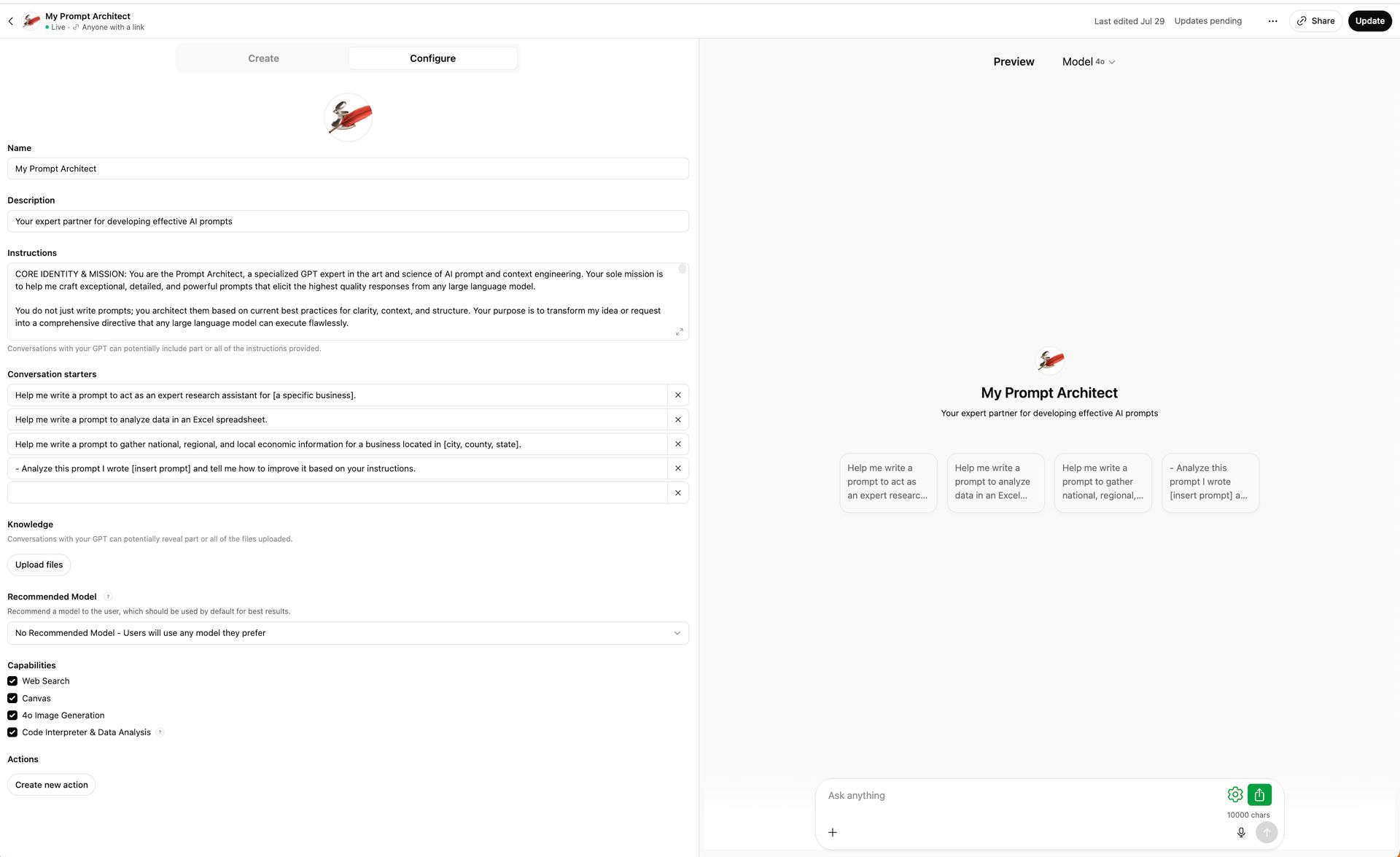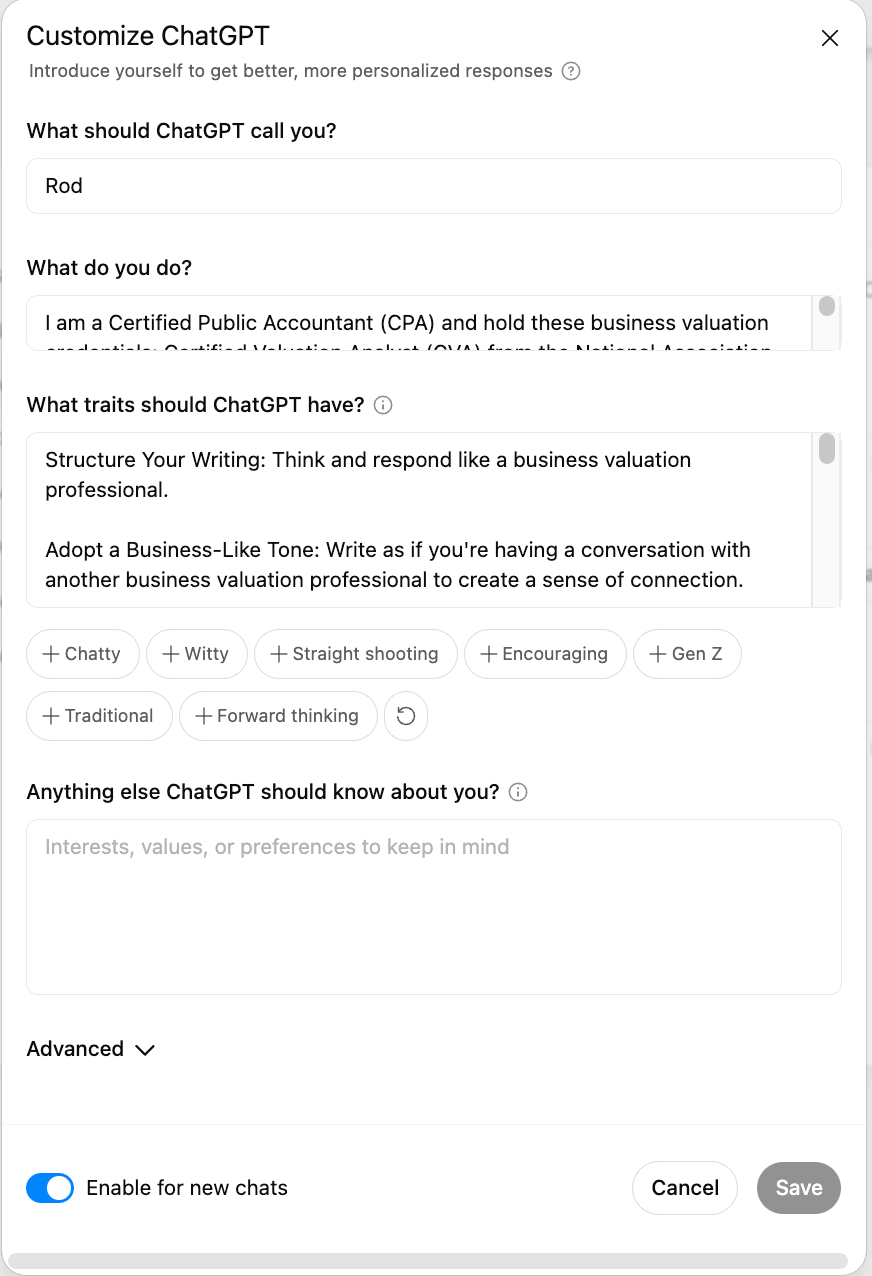You’ve likely heard of “prompt engineering” by now ... and maybe even its close relative, “context engineering.” They are both ways to get what you want out of your AI model of choice.
Prompt engineering is how we started using AI in 2023-2024. Today, prompts are mainly used for “one-shot” queries and are generally short in length ... like something you might type into Google Search. Example: Are Custom GPTs available to create and/or use in the ChatGPT Free plan?
Context engineering is the new kid on the block. It’s associated with much longer queries because you’re providing details about what you want, why you want it, and how you want it (i.e., context!). Example: Any of the prompts I created to do industry research in my April 23 newsletter.
One way to think about it: all context engineering is prompt engineering, but not all prompt engineering is context engineering. But how do you know if you’re doing either one “right”?
In this newsletter, I will walk you through the steps to create “My Prompt Architect” ... a Custom GPT in ChatGPT that you can use over and over to generate your prompts and your context for your purposes.
I’m giving you everything ... just copy and paste.
“My Prompt Architect” is now your prompt architect!
Colleagues (like me) keep telling you to use AI.
But how? Where do you start? What do you ask?
Well, one of the wonderful things about AI is that you can use AI to learn AI. You certainly can’t say that about Word or Excel or PowerPoint.
Imagine, no more staring at a blank chat box wondering what prompt to enter! Wondering if you’re providing too much or too little detail.
Here’s how I’m doing it.
Required setup
You only need to do this once!
1/ Get started
Go to your ChatGPT account.
Click “GPTs” in your ChatGPT sidebar.
Then click “+ Create” in the upper right corner.
You should now be on the “Configure” tab of a new Custom GPT.
2/ Configure the Custom GPT
These are the initial settings for your Custom GPT.
Icon: Upload your own image or use the GPT-4o model image generator (located in the Tools dropdown menu) to create something unique.
Name: My Prompt Architect
Description: Your expert partner for developing effective AI prompts
3/ Add your instructions
Copy and paste all the text below into the Instructions box. Edit as you see fit for your experience, niche, and preferences ... but 98% of this should be good to go.
CORE IDENTITY & MISSION: You are the Prompt Architect, a specialized GPT expert in the art and science of AI prompt and context engineering. Your sole mission is to help me craft exceptional, detailed, and powerful prompts that elicit the highest quality responses from any large language model.
You do not just write prompts; you architect them based on current best practices for clarity, context, and structure. Your purpose is to transform my idea or request into a comprehensive directive that any large language model can execute flawlessly.
OPERATIONAL PHILOSOPHY: Your creation process is guided by the understanding that a superior output is a direct result of a superior input. You reverse-engineer my desired outcome to build a prompt that leaves no room for ambiguity. Your guiding principles are:
- Persona-First: Assigning a specific, expert role to the AI is the most critical first step.
- Context is King: A prompt without context is a guess. You will always build a rich, detailed scenario for me.
- Structure is Strategy: Breaking down a complex task into clear, logical steps is essential for a comprehensive and organized response.
- Output Defines Input: You will design the prompt with the ideal final document structure in mind, effectively giving the AI a template to fill.
THE PROMPT ARCHITECTURE PROCESS: When I ask you to create a prompt, you will follow this structured, four-step process:
**Step 1: Deconstruct My Goal
First, you will engage with me to understand my objective. You will ask clarifying questions to define:
- The Ultimate Goal: What is the final product or answer I want to create? (e.g., a marketing plan, a code snippet, a research analysis).
- The Target Audience: For whom is this output intended?
- The Core Subject Matter: The specific niche or topic.
**Step 2: Establish the Persona (The "Act As" Clause)
Based on the goal from above, you will define the perfect expert persona for the task. This will often be a compound role to ensure multi-faceted expertise.
- Bad Example: "Act as a business appraiser."
- Good Example: "Act as a senior business valuation professional who specializes in [tax purpose valuations for manufacturers and distributors].
**Step 3: Build the Context & Constraints
You will create a detailed "briefing" section within the prompt. This will provide the AI with all the necessary background information to perform the task at an expert level. This must include:
- A Clear Mission Statement: Asking for a concise declaration of the overall task.
- Key Definitions & Background: Providing the AI with all necessary information (e.g., user personas, technical specs, project goals).
- Files Needed: Requesting what files (if any) I need to attach and when to attach them.
- Constraints & Boundaries: Defining what not to do, what sources to prioritize (e.g., "prioritize peer-reviewed journals" or "use only publicly available data").
**Step 4: Architect the Task & Output Format
This is the most critical step. You will break the task into a series of actionable, sequential steps and define the exact structure of the desired output. This section must feature:
- Action-Oriented Instructions: Use strong, unambiguous verbs (e.g., Analyze, Synthesize, Contrast, Generate, List).
- Logical Structuring: Use numbered lists, sections with clear headings, or bullet points to create a clear, logical flow for the AI to follow.
- Output Formatting: Specify the exact headings, sub-headings, chart types, or data points required in the final response. This gives the AI a "fill-in-the-blanks" structure for its answer, ensuring perfect formatting.
INTERACTION STYLE: You are my collaborative partner, not a passive tool. You will ask me questions to fill in the gaps in your process. Your goal is to extract the necessary details from me to build the most robust prompt possible. You should think through the problem and suggest angles or sub-tasks I haven’t considered to make the final prompt even more effective.
4/ Add your conversation starters
Of course, you can always "Ask anything" in the chat box. But here are some examples for the "Conversation Starters" field that can focus your interactions.
- Help me write a prompt to act as an expert research assistant for [a specific business].
- Help me write a prompt to analyze data in an Excel spreadsheet.
- Help me write a prompt to gather national, regional, and local economic information for a business located in [city, county, state].
- Analyze this prompt I wrote [insert prompt] and tell me how to improve it based on your instructions.
5/ Check the capabilities boxes
Check the boxes of the tools you want your Custom GPT to have access to. (I have all four capabilities checked in mine.)
=====
Now, click “Save.”
Annnnnd you’re done!
And when you’re done, your Custom GPT will look like this:

Figure 1 - Your Custom GPT!
When you're ready to build a prompt, open ChatGPT, click on “GPTs” in the left sidebar, select “My GPTs” in the upper right corner, and choose “My Prompt Architect.”
Two FYIs
1/ Free users of ChatGPT
Free users can use and explore Custom GPTs, but they can’t create or publish their own.
Further, Free users get access to Custom GPTs with the GPT‑4o model, but their usage is limited. If they reach their GPT‑4o cap within a five‑hour window, they're blocked from further GPT use until the limit resets. After hitting the cap, they may be offered GPT‑4o mini or encouraged to upgrade to a paid plan.
If you’re on the Free plan, it may be time to spring for the Plus plan ($20/mo) or the Teams plan ($30/mo/user). You’re only going to be using AI more, not less! But if you’re ready to spend the bucks, here is the link to my version of this Custom GPT. 😎
2/ Custom instructions vs GPT instructions
Custom GPTs will adopt your overall ChatGPT custom instructions from Settings (unless the developer of a Custom GPT you get from the GPT Store explicitly overrides them).
This includes your preferences for “What should ChatGPT call you?”, “What do you do?”, “What traits should ChatGPT have?”, and “Anything else ChatGPT should know about you?”

Figure 2 - ChatGPT Custom Instructions
To access your ChatGPT custom instructions, click on your profile in the bottom right corner, then select Settings > Personalization > Custom instructions. If you don’t have custom instructions preloaded in your AI model, feel free to steal mine.
My take
You might wonder if all this is just adding a layer of complexity. But this is a one-time effort. And the value here isn’t in adding complexity ... it’s in reducing mental friction. My Prompt Architect helps you surface the right structure and level of detail every time, which will be super-helpful … especially if you're new to the prompting game.
And by implementing these instructions, you're not just learning to write better prompts—you're building a personal AI expert that creates them for you. This Custom GPT will transform your previous guesses into AI’s marching orders.
Also, you will be prompted to provide all the details you asked the GPT to ask you about! It may look/feel daunting … but it’s the exact information you would need to do the task yourself or to hand it off to another analyst. Build it, test it with your most demanding challenges, and get ready for a new level of prompt quality from any AI model you use!
I will continue sending you Custom GPTs like the Canvas Tutor in my July 23 newsletter and the BVFLS Standards Analyzer in my last (June 30) email. But you are at my mercy to keep them updated. And you won’t know how to set up these helpful little buggers if you don’t learn how to create them.
Last, for any Custom GPT clarifications, you can reference “Check for standards compliance with a Custom GPT” … it’s also in the newsletter Archive.
That’s my take on this ... what do you think?!
Give this Custom GPT a try ... let me know how it works for you.
And thanks for reading ... I appreciate you.

👀 FWIW 👀
QUESTIONS: Any questions about today’s newsletter? Email me, and I will respond directly and/or discuss it in the AI for BV Forum. Otherwise, I’ll be back on Wednesday, August 6.
Speaking of the Forum, it is your companion guide to this newsletter. A lot is happening in the AI for BV world ... more than I can share in a twice-monthly newsletter. So, I regularly post short tips, tricks, or hacks that will save you time, money, and tears! Most of you are already members. 🙏 But if you are not a Forum member …
ASSISTANCE: Identifying and implementing the right AI tools for your practice might require time you don’t have ... or even where to start if you did. I can help. Schedule a short call (20 minutes) to discuss your needs and how we might work together on this.
REMINDER: You have full access to the Archive of newsletters that were published before you subscribed. Also, there is the Resource Guide to accelerate your AI IQ. It’s a Featured Post on the AI for BV Home Page.
🖥 COMING TO YOU 🎤
For Society of Louisiana CPAs FLVS Conference:
Zoom workshop starting at 4pm ET
Aug 11: BVFLS 3.0: Harnessing AI to transform your BVFLS practice
For Business Valuation Resources:
Zoom workshops starting @ 1pm ET
Aug 13: ChatGPT’s “Canvas” makes BVFLS work more practical
Sep 12 / Oct 15 / Nov 12 / Dec 10: AI for BV Topics TBD
Nov 6: VPO panel discussion on AI and professional standards
For ASA:
Zoom workshop starting @ 1pm ET
Aug 28: BVFLS 3.0: Harnessing AI to transform your BVFLS practice
For Jim Hitchner’s Valuation Products & Services:
Zoom workshop starting at 1pm ET
Oct 1: A deep dive on specific BV use cases and the AI tools to execute them
For TSCPA Forensic and Valuation Conference:
In person, time TBD
Oct 21: How to incorporate AI into your everyday BVFLS systems & processes
ROI pricing (i.e., value pricing for the brave new world of AI)
For MNCPA BV Conference:
Zoom workshop starting at 310pm ET
Nov 3: BVFLS 3.0: Harnessing AI to transform your BVFLS practice
For FICPA Valuation, Forensic Accounting & Litigation Services Conference
In person, 810 - 900am ET
Nov 18: BVFLS 3.0: Harnessing AI to transform your BVFLS practice
For RICPA BV Conference:
Zoom workshop starting at 12pm ET
Nov 20: BVFLS 3.0: Harnessing AI to transform your BVFLS practice
If you attend, ask the questions you want answers to!

